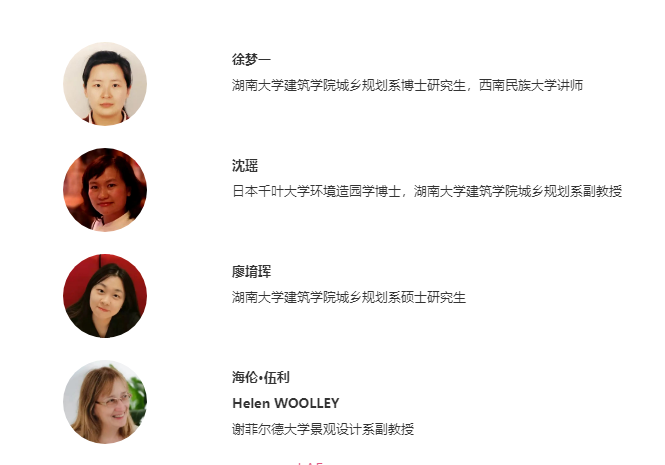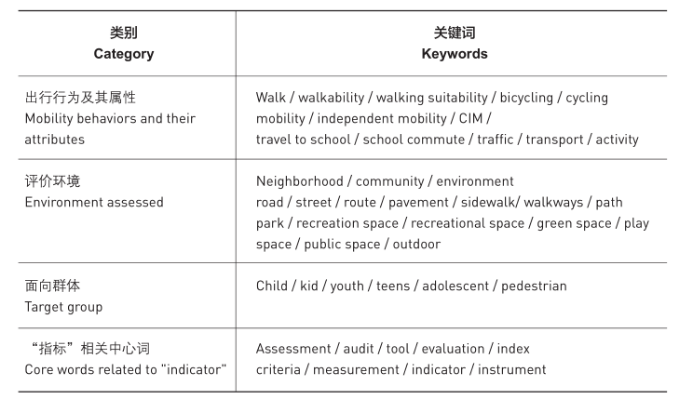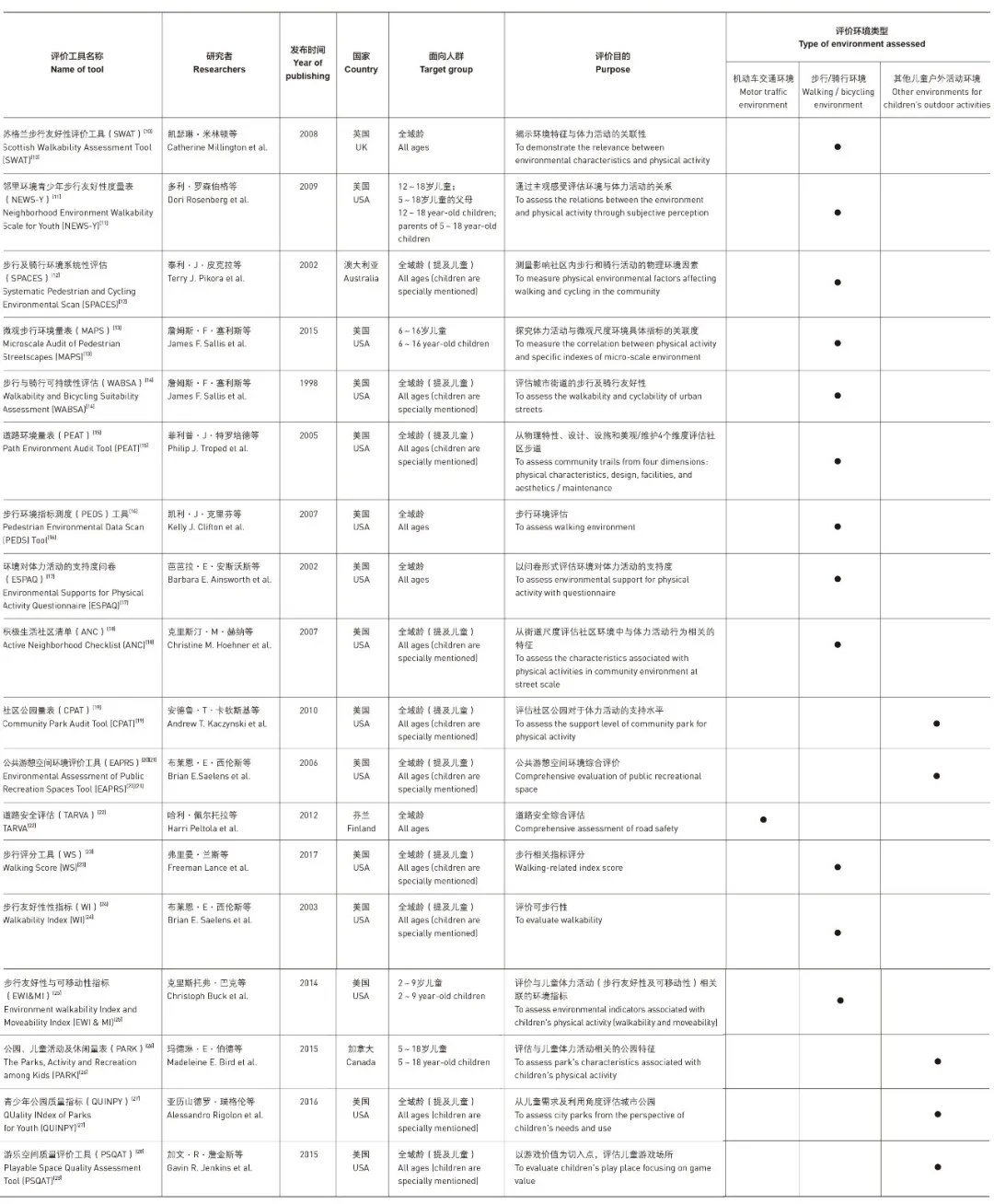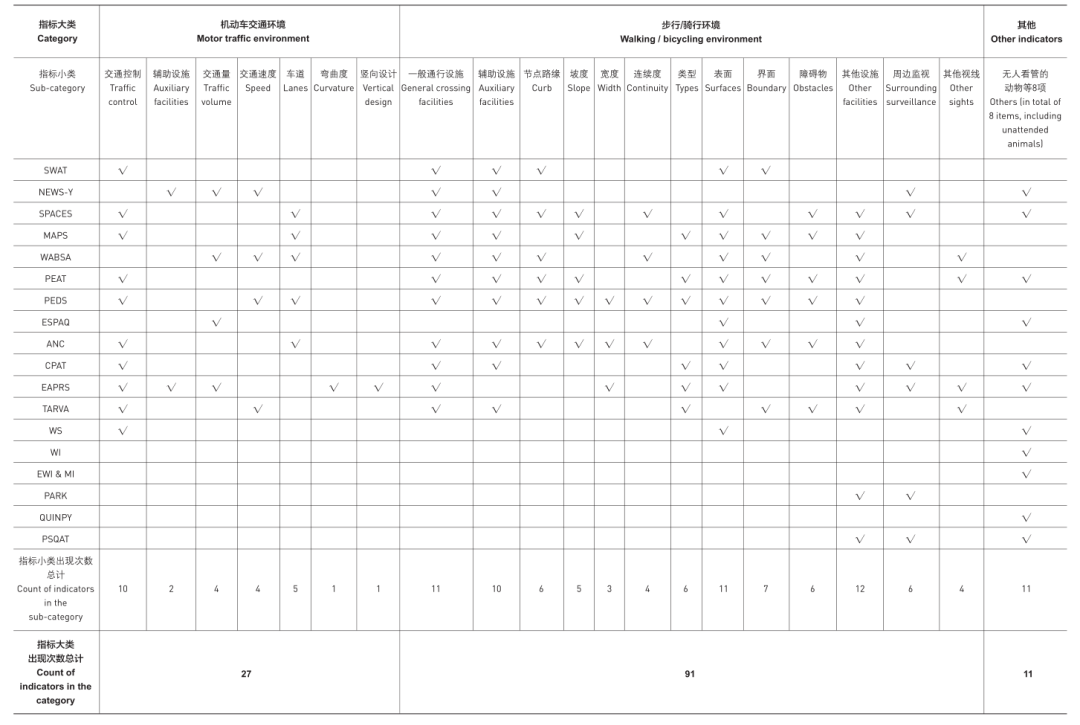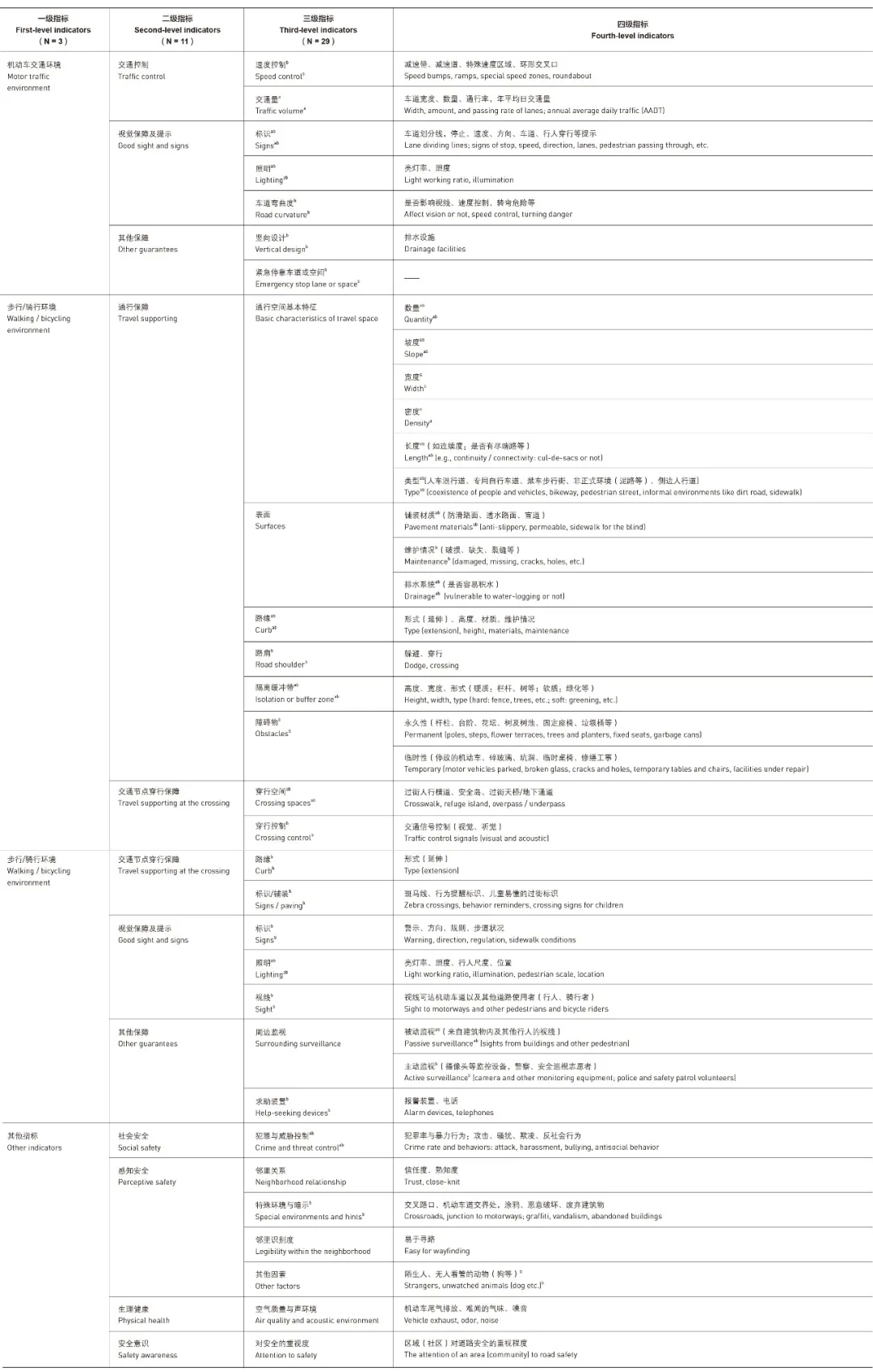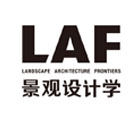[1] Qiu, B. (2007). China's paradigm in the third urbanization wave. City Planning Review, 31(6), 9-15.
[2] UNICEF. (2018). Child Friendly Cities Initiative Handbook. Retrieved from https://www.unicef.org/media/56291/file/%E5%84%BF%E7%AB%A5%E5%8F%8B%E5%A5%BD%E5%9E%8B%E5%9F%8E%E5%B8%82%E8%A7%84%E5%88%92%E6%89%8B%E5%86%8C.pdf
[3] Millington, C., Thompson, C. W., Rowe. D. A., Aspinall, P., Fitzsimons, C., Nelson, N. M., & Mutrie, N. (2009). Development of the Scottish Walkability Assessment Tool (SWAT). Health and Place, 15(2), 474-481. doi:10.1016/j.healthplace.2008.09.007
[4] Rosenberg, D. E., Ding, D., Sallis, J. F., Kerr, J., Norman, G. J., Durant, N., … Saelens, B. E. (2009). Neighborhood Environment Walkability Scale for Youth (NEWS-Y): Reliability and Relationship with Physical Activity. Preventive Medicine, 49(2), 213-218. doi:10.1016/j.ypmed.2009.07.011
[5] Pikora, T., Bull, F., Jamrozik. K., Knuiman, M., Gilescorti, B., & Donovan, R. J. (2002). Developing a reliable audit instrument to measure the physical environment for physical activity. American Journal of Preventive Medicine, 23(3), 187-194. doi:10.1016/S0749-3797(02)00498-1
[6] Sallis, J. F., Cain, K. L., Conway. T. L., Gavand, K. L., Millstein, R. A., Geremia, C. M., … King, A. C. (2015). Is Your Neighborhood Designed to Support Physical Activity? A Brief Streetscape Audit Tool. Preventing Chronic Disease, 12(9), 1-11. doi:10.5888/pcd12.150098
[7] Emery, J., Crump, C., & Bors, P. (1998). Walking and Bicycling Suitability Assessment. Retrieved from http://wabsa.web.unc.edu/
[8] Troped, P. J., Cromley, E. K., Fragala, M. S., Melly, S. J., Hasbrouch, H. H., Gortmaker, S. L., & Brownson, R. C. (2006). Development and Reliability and Validity Testing of an Audit Tool for Trail/Path Characteristics: The Path Environment Audit Tool (PEAT). Journal of Physical Activity and Health, 3(S1), S158-S175. doi:10.1123/jpah.3.s1.s158
[9] Clifton, K. J., Smith, A. L., & Rodriguez, D. A. (2007). The Development and Testing of an Audit for the Pedestrian Environment. Landscape and Urban Planning, 80(1), 95-110. doi:10.1016/j.landurbplan.2006.06.008
[10] Williams, J. E., Evans, M., Kirtland, K. A., Cavnar, M. M., Sharpe, P. A., Neet, M. J., … Cook, A. (2005). Development and Use of a Tool for Assessing Sidewalk Maintenance as an Environmental Support of Physical Activity. Health Promotion Practice, 6(1), 81-88. doi:10.1177/1524839903260595
[11] Hoehner, C. M., Ivy, A., Brennan Ramirez, L. K., Handy, S. L., & Brownson, R. C. (2007). Active Neighborhood Checklist: A User-Friendly and Reliable Tool for Assessing Activity-Friendliness. American Journal of Health Promotion, 21(6), 534-537. doi:10.4278/0890-1171-21.6.534
[12] Kaczynski, A. T., Wilhelm Stanis, S. A., Besenyi, G. M. (2012). Development and Testing of a Community Stakeholder Park Audit Tool. American Journal of Preventive Medicine, 42(3), 242-249. doi:10.1016/j.amepre.2011.10.018
[13] Saelens, B. E., Frank, L. D., Auffrey, C., Whitaker, R. C., Burdette, H. L., & Colabianchi, N. (2006). Measuring Physical Environments of Parks and Playgrounds: EAPRS Instrument Development and Inter-Rater Reliability. Journal of Physical Activity and Health, 3(s1), 190-207. doi:10.1123/jpah.3.s1.s190
[14] Saelens, B. E. (2006, July). Environmental Assessment of Public Recreation Spaces (EAPRS) Tool. Retrieved from https://www.activelivingresearch.org/environmental-assessment-public-recreation-spaces-eaprs-tool
[15] Peltola, H., Rajam?ki, R., & Luoma, J. (2013). A tool for safety evaluations of road improvements. Accident Analysis and Prevention, (60), 277-288. doi:10.1016/j.aap.2013.04.008
[16] Freeman, L., Neckerman, K. M., Schwartz-Soicher, O., Quinn, J. W., Richards, C., Bader, M. D. M., … Rundle, A. (2013). Neighborhood walkability and active travel (walking and cycling) in New York City. Journal of Urban Health-bulletin of The New York Academy of Medicine, 90(4), 575-585. doi:10.1007/s11524-012-9758-7
[17] Saelens, B. E., Sallis, J. F., & Frank, L. D. (2003). Environmental correlates of walking and cycling: Findings from the transportation, urban design, and planning literatures. Annals of Behavioral Medicine, 25(2), 80-91. doi:10.1207/S15324796ABM2502_03
[18] Buck, C., Tkaczick, T., Pitsiladis, Y. P., De Bourdehaudhuij, I., Reisch, L. A., Ahrens, W., & Pigeot, I. (2014). Objective measures of the built environment and physical activity in children: From walkability to moveability. Journal of Urban Health-bulletin of The New York Academy of Medicine, 92(1), 24-38. doi:10.1007/s11524-014-9915-2
[19] Bird, M. E, Datta, G. D., Van Hulst, A., Kestens, Y., & Barnett, T. A. (2015). A reliability assessment of a direct-observation park evaluation tool: The Parks, Activity and Recreation among Kids (PARK) tool. BMC Public Health, 15(1), 906-916. doi:10.1186/s12889-015-2209-0
[20] Rigolon, A., & Németh, J. (2018). A QUality INdex of Parks for Youth (QUINPY): Evaluating urban parks through geographic information systems. Environment and Planning B: Planning and Design, 45(2), 275-294. doi:10.1177/0265813516672212
[21] Jenkins, G., Yuen, H. K., Rose, E. J., Maher, A. I., Gregory, K. C., & Cotton, M. E. (2015). Disparities in Quality of Park Play Spaces between Two Cities with Diverse Income and Race/Ethnicity Composition: A Pilot Study. International Journal of Environmental Research and Public Health, 12(7), 8009-8022. doi:10.3390/ijerph120708009
[22] UNICEF. (2018, April). Child Friendly Cities and Communities Handbook. Retrieved from https://www.unicef.org/eap/reports/child-friendly-cities-and-communities-handbook
[23] Orso, G., & Migliore, M. (2020). A GIS-based method for evaluating the walkability of a pedestrian environment and prioritised investments. Journal of Transport Geography, (82), 102555. doi:10.1016/j.jtrangeo.2019.102555
[24] Janssen, I., Ferrao, T., & King, N. (2016). Individual, family, and neighborhood correlates of independent mobility among 7 to 11-year-olds. Preventive Medicine Reports, (23), 98-102. doi:10.1016/j.pmedr.2015.12.008
[25] Carver, A., Panter, J., Jones, A., & Van Sluijs, E. M. F. (2014). Independent mobility on the journey to school: A joint cross-sectional and prospective exploration of social and physical environmental influences. Journal of Transport and Health, 1(1), 25-32. doi:10.1016/j.jth.2013.12.003
[26] Lin, E., Witten, K. Oliver, M. Carroll, P., Asiasiga, L., Badland, H., & Parker, K. (2017). Social and built-environment factors related to children’s independent mobility: The importance of neighbourhood cohesion and connectedness. Health and Place, (46), 107-113. doi:10.1016/j.healthplace.2017.05.002
[27] Kytta, M. (2004). The extent of children’s independent mobility and the number of actualized affordances as criteria for child-friendly environments. Journal of Environmental Psychology, 24(2), 179-198. doi:10.1016/S0272-4944(03)00073-2
[28] Ghekiere, A., Deforche, B., Carver, A., Mertens, L., De Geus, B., Clarys, P., … Van Cauwenberg, J. (2017). Insights into children’s independent mobility for transportation cycling: Which socio-ecological factors matter? Journal of Science and Medicine in Sport, 20(3), 267-272. doi:10.1016/j.jsams.2016.08.002
[29] Sharmin, S., & Kamruzzaman, M. (2017). Association between the built environment and children’s independent mobility: A meta-analytic review. Journal of Transport Geography, (61), 104-117. doi:10.1016/j.jtrangeo.2017.04.004
[30] Gilbert, H., Whitzman, C., & Pieters, J., & Allan, A. (2018). Children’s everyday freedoms: Local government policies on children and sustainable mobility in two Australian states. Journal of Transport Geography, (71), 116-129. doi:10.1016/j.jtrangeo.2018.07.007
[31] Buliung, R., Larsen, K., Faulkner, G., & Ross, T. (2017). Children’s independent mobility in the City of Toronto, Canada. Travel Behaviour and Society, (9), 58-69. doi:10.1016/j.tbs.2017.06.001
[32] Stark, J., Frühwirth, J., & Aschauer, F. (2018). Exploring independent and active mobility in primary school children in Vienna. Journal of Transport Geography, (68), 31-41. doi:10.1016/j.jtrangeo.2018.02.007
[33] Cordovil, R., Lopes, F., & Neto. C. (2015). Children’s (in)dependent mobility in Portugal. Journal of Science and Medicine in Sport, 18(3), 299-303. doi:10.1016/j.jsams.2014.04.013
[34] Bhosale, J., Duncan, S., & Schofield, G. (2017). Intergenerational change in children’s independent mobility and active transport in New Zealand children and parents. Journal of Transport and Health, (7), 247-255. doi:10.1016/j.jth.2017.09.004
[35] Ruiz-Padillo, A., Pasqual, F. M., Uriarte, A. M. L., & Cybis, H. B. B. (2018). Application of multi-criteria decision analysis methods for assessing walkability: A case study in Porto Alegre, Brazil. Transportation Research Part D: Transport and Environment, (63), 855-871. doi:10.1016/j.trd.2018.07.016
[36] Schoeppe, S., Duncan, M. J., Badland, H., Oliver, M., & Curtis, C. (2013). Associations of children’s independent mobility and active travel with physical activity, sedentary behaviour and weight status: A systematic review. Journal of Science and Medicine in Sport, 16(4), 312-319. doi:10.1016/j.jsams.2012.11.001
[37] Veitch, J., Carver, A., Salmon, J., Abbott, G., Ball, K., Crawford, D., … Timperio, A. (2017).What predicts children’s active transport and independent mobility in disadvantaged neighborhoods? Health and Place, (44), 103-109. doi:10.1016/j.healthplace.2017.02.003
[38] Crawford, S., Bennetts, S. K., Hackworth, N. J., Green, J., Graesser, H., Cooklin, A., … Nicholson, J. M. (2017). Worries, ‘weirdos’, neighborhoods and knowing people: a qualitative study with children and parents regarding children’s independent mobility. Health and Place, (45), 131-139. doi:10.1016/j.healthplace.2017.03.005
[39] Long, Y., & Chen, Y. (2017). A special issue on street walkability in Shanghai Planning Review. Retrieved from https://www.beijingcitylab.com/projects-1/22-street-urbanism/
[40] Weitzman, C., Chen, Y., & Luo, Z. (2008). Policies and Practices that Promote Children's Independent Mobility. Urban Planning International, 23(5), 56-61. doi:10.3969/j.issn.1673-9493.2008.05.009
[41] Meng, X., Li, L., & Fu, B. (2019). Progress and Enlightenment of Research on Children’s Independent Activity Abroad. Human Geography, 34(4), 20-31.
[42] Natural Resources Defense Council, & School of Architecture, Tsinghua University. (2019, May). Evaluation of walkability in Chinese Cities — Research on Walkability of Urban Vitality Center. Retrieved from https://www.beijingcitylab.com/projects-1/22-street-urbanism/

 京公海網(wǎng)安備 110108000058號(hào)
京公海網(wǎng)安備 110108000058號(hào)
